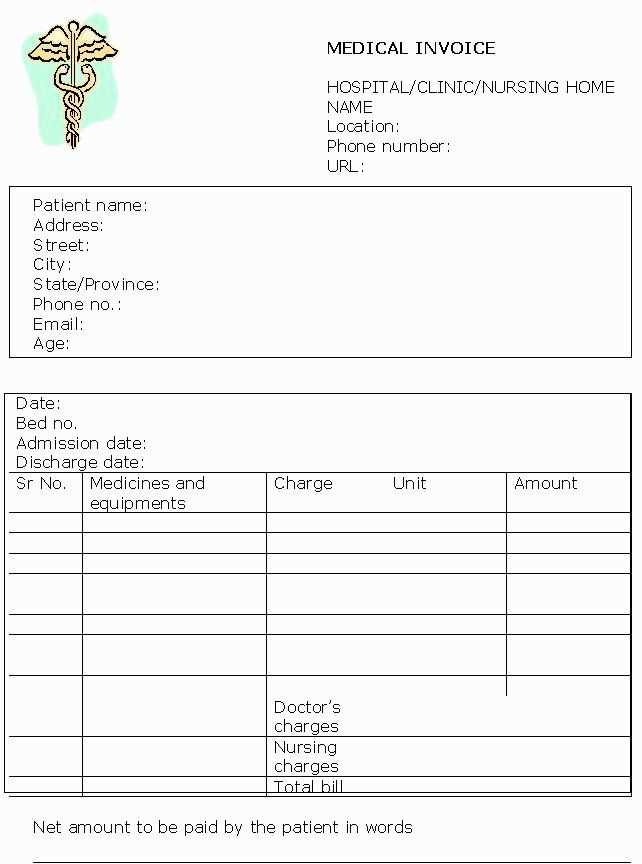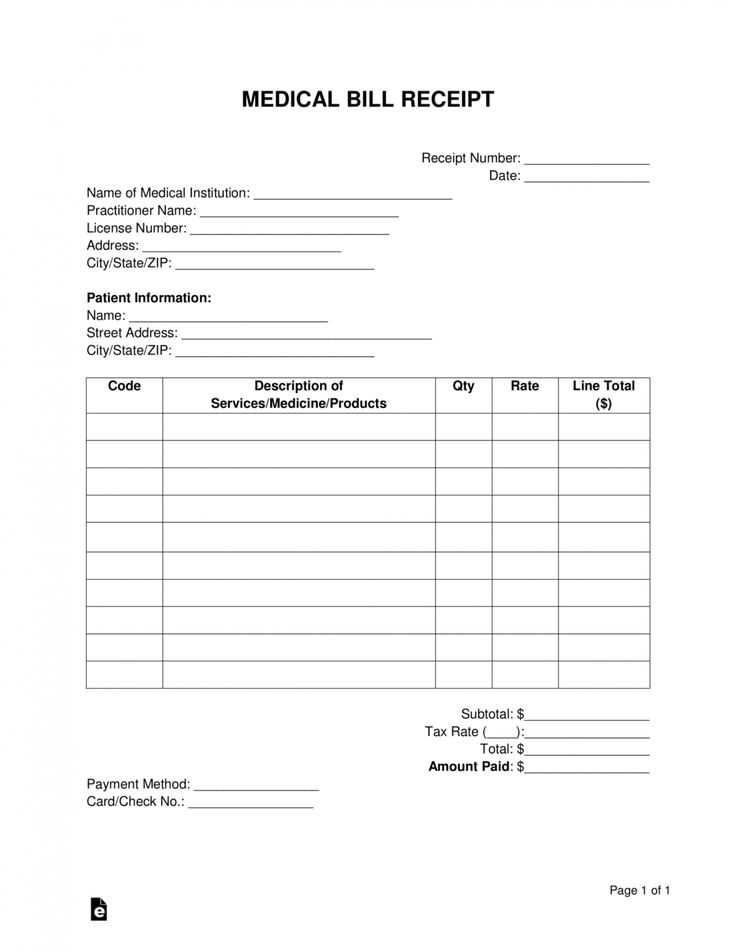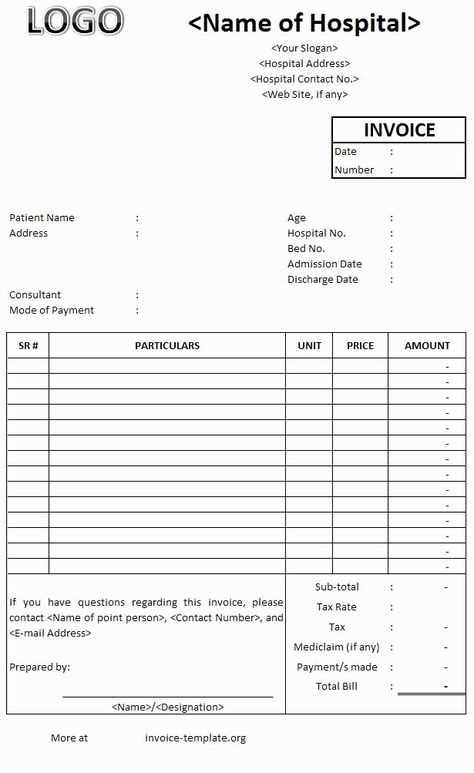
Creating a clear and organized hospital bill receipt template can simplify the billing process and ensure transparency between healthcare providers and patients. This template should include key details such as the patient’s name, treatment dates, services provided, and the amount charged for each service. A well-structured receipt eliminates confusion and provides an accurate record of payments made and remaining balances.
Incorporate sections for payment method, insurance coverage (if applicable), and a breakdown of charges. Including contact information for both the healthcare facility and the patient ensures prompt communication in case of discrepancies. A footer with terms of payment, such as due dates or late fees, adds clarity to the financial terms.
When designing the layout, use simple fonts and adequate spacing. This makes it easy for both the provider and the patient to read and review the receipt. Ensure that all figures are aligned correctly and include clear labels for each item, helping to prevent any misunderstandings.
Hospital Bill Receipt Template: A Practical Guide
Begin by focusing on clarity and precision when creating a hospital bill receipt template. Ensure the following elements are included: the patient’s name, the service date, detailed breakdown of charges, and payment information. Each section should be clearly labeled to avoid confusion.
Key Components of a Hospital Bill Receipt
List all hospital services provided, such as consultation, lab tests, surgeries, and medications. For each, specify the cost, any discounts or insurance contributions, and the total amount due. This breakdown helps patients understand exactly what they are paying for.
Formatting Tips for Readability
Use a clear, structured layout. Headings should be distinct, with a clean font and enough space between sections. Avoid overly complicated designs that can distract from the key information. Keep the font size legible and consistent across the template.
Ensuring Accuracy in Payment Details
Verify payment details, including any amounts paid or outstanding. Clearly display the payment method used, whether credit card, insurance, or cash, and include transaction references if applicable. Double-check the final balance for accuracy before issuing the receipt.
Legal and Compliance Requirements
Ensure the template complies with local healthcare billing regulations. This may include specific tax details, healthcare provider identifiers, and patient privacy protections. Always stay updated on the required legal standards for your region.
Customizing the Template for Different Needs
Modify the template to suit specific hospital departments or types of care. For example, add sections for emergency services, outpatient visits, or inpatient stays. Customizing the receipt will improve clarity and ensure patients get accurate billing information for each service.
Understanding the Key Components of a Hospital Bill
When reviewing a hospital bill, focus on these key sections to fully understand what you’re being charged for:
1. Patient Information

- Name, date of birth, and patient ID
- Insurance details, if applicable
2. Services Provided
- Room charges: This may include daily rates for inpatient services.
- Medical procedures: Look for specific codes (CPT or ICD-10) representing the treatments you received.
- Medications: Ensure all prescribed drugs and dosages are listed.
- Laboratory and diagnostic tests: Tests such as bloodwork or imaging scans like X-rays.
- Physician and specialist fees: Charges for doctors’ consultations and any specialist services.
3. Charges and Payments
- Itemized list of each service with its corresponding charge
- Insurance adjustments: What your insurer covers and what remains your responsibility
- Payments made: Amounts already paid, either through insurance or out-of-pocket.
4. Total Balance
- The final amount due after insurance adjustments and previous payments.
How to Customize Your Bill Receipt Template
Adjust the layout to match your business’s branding. Use a clean, simple structure that includes your logo, business name, and contact details at the top. Ensure these elements are easy to read and consistent across all documents.
Modify the Sections

Customize the sections to suit the type of service provided. Include fields for patient or customer name, date of service, detailed itemization, and total amount due. You may also want to add payment method details, as well as any taxes or discounts applied.
Choose Fonts and Colors

Pick a font that is clear and legible. Avoid overly decorative styles, especially for important details like amounts or dates. Use brand colors for headings and borders, but keep the body text neutral for easy reading.
Ensure that each section is well-defined with lines or spacing. A structured format helps customers easily understand the breakdown of charges.
Creating a Bill Receipt Using Templates and Tools
To create a bill receipt efficiently, begin by selecting a reliable template that suits your needs. Many online tools offer customizable templates with all the necessary fields to ensure clarity and accuracy. These templates typically include spaces for the patient’s name, hospital services, date of service, and itemized charges.
Choosing the Right Template
Opt for a template that matches your specific requirements. For instance, if the bill includes various departments like surgery or radiology, make sure the template allows you to break down these categories. Look for templates with clear headings, easily editable sections, and an organized layout to enhance readability.
Utilizing Online Tools
There are several free and paid online tools available to streamline the process. Tools like Microsoft Excel or Google Sheets provide templates that can be modified quickly. For more advanced features, consider using specialized receipt generator tools that automatically calculate totals and taxes based on input data.
Ensuring Accuracy in Receipt Information
Double-check that the patient’s name and contact details are accurate, matching the records. Verify the date of service and ensure the listed treatments and medications align with what was provided. Cross-reference the billing codes with the services performed to avoid discrepancies.
Carefully review each charge, confirming that all services are correctly listed and categorized. Ensure the costs for each procedure, medication, or consultation are consistent with the agreed rates. If there are any discrepancies or unclear charges, contact the billing department for clarification.
Confirm that any insurance payments or coverage details are reflected accurately. Adjustments, co-pays, or any partial payments should be clearly itemized, and the patient’s remaining balance should be easy to identify. Review any refunds, discounts, or credits applied to the bill to ensure they are properly accounted for.
Ensure that the contact information for billing inquiries, including phone numbers or email addresses, is up-to-date. This helps patients resolve any billing issues quickly if necessary.
Legal Considerations for Hospital Billing
Hospitals must ensure that billing practices comply with local, state, and federal regulations. Accurate billing reflects the medical services provided, and failure to follow proper procedures can result in legal consequences, including penalties or lawsuits.
Billing Transparency
Patients have the right to receive clear, detailed invoices for all services rendered. The bill should outline each charge, including hospital stays, tests, surgeries, and any other related services. It’s crucial to provide patients with an itemized bill and ensure that all charges align with the services provided.
Insurance Compliance
- Verify insurance coverage before billing, including the specifics of the patient’s plan.
- Ensure that the hospital complies with insurance provider protocols, such as pre-authorizations and referrals.
- Ensure accurate coding for medical procedures to avoid insurance disputes.
Hospitals must adhere to insurance rules to avoid complications in claims. Incorrect coding or failure to follow the insurance provider’s procedures can result in delayed payments or denials. This also protects the hospital from any allegations of fraud.
Patient Rights and Billing Disputes
- Patients have the right to dispute incorrect charges, and hospitals must have a clear process for addressing these disputes.
- Offer payment plans for patients who may struggle to pay their bills in full.
- Maintain confidentiality by ensuring all billing information complies with the Health Insurance Portability and Accountability Act (HIPAA).
Hospitals should have a dispute resolution procedure in place to handle patient complaints about billing errors. Clear communication between hospital staff and patients helps minimize conflicts and build trust. Adherence to HIPAA is crucial to protect patient privacy throughout the billing process.
Tips for Simplifying Patient Understanding of Billing Receipts
Clarify the breakdown of charges. Use simple, familiar language to describe services and fees. Avoid technical terms or jargon that can confuse patients. For example, instead of “anesthesia administration,” write “pain management during the procedure.”
Use clear headings. Organize the receipt into distinct sections such as “Consultation,” “Treatment,” and “Medication.” This approach makes it easier for patients to follow the charges and understand what each item represents.
| Service | Cost |
|---|---|
| Initial Consultation | $150 |
| X-ray | $200 |
| Prescribed Medication | $50 |
Offer a total summary. Present the overall amount due clearly at the end, with a brief note on payment options. Include insurance coverage details, if applicable, to show what has been covered and what remains the responsibility of the patient.
Provide contact details for billing inquiries. Make sure patients know who to reach out to for clarification or questions. A clear phone number or email address can prevent confusion and delays in payment processing.


